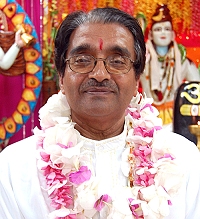From a satsang with Paramacharya of SWAHA, Pt. Hardeo Persad
Hindu mythology states that the Ganga flowed from the heavenly regions into the matted locks of Shivaji, and were then released gently to the earthly plane. These mythological tales are steeped in meaningful symbolism of universal principles that affect each of us. On the physical level, Ganga flows from the peaks of Gowmukh, Mt. Himalay and converges with the Yamuna and the subterranean stream, Saraswati in a holy confluence in Triveni at Prayag; on the metaphysical level, there is also an inner Ganga, the stream of devotion, within each of us. We could visit India and bathe in the Ganga for spiritual purification but it is more important that we develop and bathe in the stream of devotion, bhakti. Bhakti is pure, unselfish love for God, a love that gives of everything and asks for nothing in return.
Shivaji, from whose hair the Ganga flows, represents the state of vairaagya, mental detachment or dispassion. It is the state of being in the world but not of it. Achieving and living in the state of detachment means giving up that which is unnecessary and gravitating towards the spiritual reality. It is a state of equanimity that distances the devotee from the attractions and aversions of the world. When we achieve this state of detachment, we gain control over the praan vaayu (vital airs) and the body’s metabolic activities. When we face challenges in life, a sense of detachment permits us to maintain unshakeable faith in divinity, and an understanding that everything in life is temporary, including our challenges.
Performing religious activities and worshipping Bhagavan Shiva is an important step in gaining spiritual dispassion, in that, when performed with bhaav (an attitude of love), they lead us to discover and develop that stream of devotion. It is one of the reasons why the sages performed all types of sacrifices, penance and pilgrimage. The purpose of such religious activity is to climb beyond the imperfections of the mind. If we stabilise the mind and senses and develop that state of detachment, the stream of devotion will flow. Intensely pursuing the path of devotion in accordance with scriptural injunctions is indeed akin to diving into the purifying depths of the Ganga, and is conducive to the attainment of the state of oneness with the Divine.
Yajur Veda states, Yatha pinde tatha brahmande, yatha brahmande tatha pinde, that is, “As the microcosm, so is the macrocosm; as the macrocosm, so too, the microcosm.” Contextually applied, the three sacred rivers that flow through India also flow metaphysically within the subtle human body. The Ida Naadi, Pingla Naadi and Sushumna Naadi are three major naadis or streams of bio-energy that are a source of sustenance within the subtle body. They are symbolic of the physical rivers and signify devotion, knowledge and disinterested action. As the three rivers merge in Triveni at Prayag, so too, within us, these naadis merge at ajna chakra in the forehead. Here, the harmonised, rhythmic flow of devotion, accelerated by wisdom and disinterested action merges into a unifying flow of devotion and blessedness. It is an unending source of nourishment, from physical sustenance to spiritual purification.



